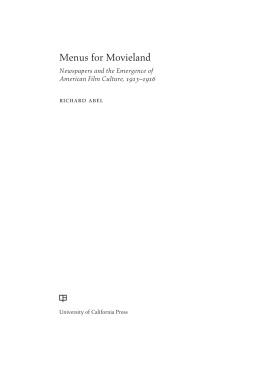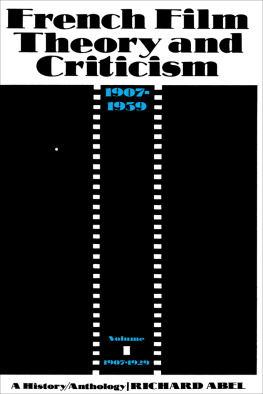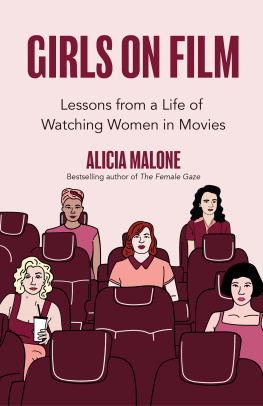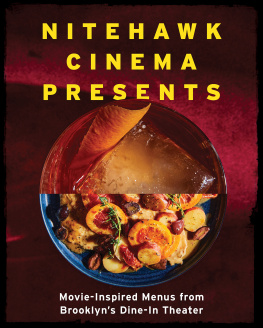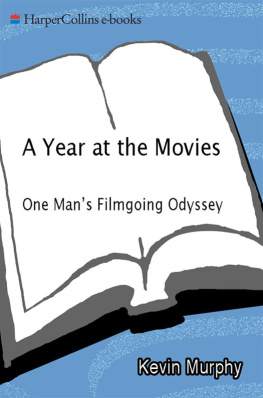Copyright 2015. University of California Press. All rights reserved. May not be reproduced in any form without permission from the publisher, except fair uses permitted under U.S. or applicable copyright law.
EBSCO Publishing : eBook Academic Collection (EBSCOhost) - printed on 1/27/2022 11:42 PM via
AN: 1030318 ; Richard Abel.; Menus for Movieland : Newspapers and the Emergence of American Film Culture, 19131916
Account: s8381174
The publisher gratefully acknowledges the generous support of the Ahmanson Foundation Humanities Endowment Fund of the University of California Press Foundation.
EBSCOhost - printed on 1/27/2022 11:42 PM via . All use subject to https://www.ebsco.com/terms-of-use
Menus for Movieland
Newspapers and the Emergence of American Film Culture, 19131916
RICHARD ABEL

UNIVERSITY OF CALIFORNIA PRESS
EBSCOhost - printed on 1/27/2022 11:42 PM via . All use subject to https://www.ebsco.com/terms-of-use
University of California Press, one of the most distinguished university presses in the United States, enriches lives around the world by advancing scholarship in the humanities, social sciences, and natural sciences. Its activities are supported by the UC Press Foundation and by philanthropic contributions from individuals and institutions. For more information, visit www.ucpress.edu.
University of California Press
Oakland, California
2015 by the Regents of the University of California
Several chapters and entractes are revised and expanded versions of conference papers and earlier published essays: From Path to Paramount: Visual Design in Movie Advertising, 19051914, Domitor Conference, Northwestern University, June 25, 2014; Daily Talks by Mary Pickford: Who Was That Smiley, Golden-Haired Girl? Critical M.A.S.S. symposium, Michigan State University, April 19, 2014; A Great New Field for Women Folk: Newspapers and the Movies, 19111916, Women and the Silent Screen conference, Melbourne, Australia, September 30, 2013; What Cinema Was in the Newspapers, 19141915, SCMS Conference, Chicago, March 8, 2013; Edna Vercoes Romance with the Movies, Women and the Silent Screen Conference, Bologna, June 24, 2010; Zip! Zam! Zowie!: A New Take on U.S. Cinemas Institutionalization, Historical Journal of Film, Radio, and Television 20, no. 4 (December 2009): 42132; The Movies in a Not So Visible Place: Des Moines, Iowa, 19111914, in Kathryn Fuller-Seeley, ed., Hollywood in the Neighborhood: Historical Case Studies of Local Moviegoing (University of California Press, 2008), 10729; Trash Twins: Newspapers and Moving Pictures, Americanizing the Movies and Movie-Mad Audiences, 19101914 (University of California Press 2006), 21527; Fan Discourse in the Heartland: The Early 1910s, Film History 18, no. 2 (2006): 14053.
Library of Congress Cataloging-in-Publication Data
Abel, Richard, 1941.
Menus for movieland : newspapers and the emergence of American film culture / Richard Abel.
p. cm.
Includes bibliographical references and index.
ISBN 978-0-520-28677-1 (cloth : alk. paper)
ISBN 978-0-520-28678-8 (pbk. : alk. paper)
ISBN 978-0-520-96188-3 (ebook)
1. Motion picturesPress coverageUnited StatesHistory20th century. 2. NewspapersSocial aspectsUnited States. 3. Motion picturesUnited StatesMarketing. 4. Motion picturesUnited StatesHistory20th century. I. Title.
PN1993.5.U6A676 2015
384.80973dc232015011451
Manufactured in the United States of America
24 23 22 21 20 19 18 17 16 15
10 9 8 7 6 5 4 3 2 1
In keeping with a commitment to support environmentally responsible and sustainable printing practices, UC Press has printed this book on Natures Natural, a fiber that contains 30 percent postconsumer waste and meets the minimum requirements of ANSI / NISO Z 39.481992 ( R 1997) ( Permanence of Paper ).
EBSCOhost - printed on 1/27/2022 11:42 PM via . All use subject to https://www.ebsco.com/terms-of-use
For Barbara, the Divine Ms. B
EBSCOhost - printed on 1/27/2022 11:42 PM via . All use subject to https://www.ebsco.com/terms-of-use
Oh! Piglet, said Pooh excitedly, were going on an Expedition, all of us, with things to eat. To discover something.
To discover what? said Piglet anxiously.
Oh! Just something.
Nothing fierce?
....
Oh, Pooh! Do you think its aaaa Woozle?
A.A. MILNE , Winnie-The-Pooh (New York: E.P. Dutton, 1926)
EBSCOhost - printed on 1/27/2022 11:42 PM via . All use subject to https://www.ebsco.com/terms-of-use
Contents
EBSCOhost - printed on 1/27/2022 11:42 PM via . All use subject to https://www.ebsco.com/terms-of-use
Illustrations
Reproductions of period newspaper pages, columns, and ads often lack clarity because they survive on microfilm or in digital files drawn from microfilm. I have selected some illustrations to give an idea of different newspaper page designs and others from newspapers that are the most legible.
EBSCOhost - printed on 1/27/2022 11:42 PM via . All use subject to https://www.ebsco.com/terms-of-use
Acknowledgments
I am deeply grateful for the sustained encouragement and support received during the long period of this books writing.
Several institutions provided crucial funding for the extensive research required: a 201112 National Endowment for the Humanities fellowship as well as the Collegiate Professorship and other funds from the College of Literature, Sciences, and the Arts at the University of Michigan.
The readers of a draft manuscript for the University of California Press offered invaluable assistance. Mark Garrett Cooper was especially generous in his recommendations and suggested several good ideas for reorganizing the prologue and introduction as well as writing concluding paragraphs to several chapters and entractes. Though less generous, the second anonymous reader did prod me to make my objectives and arguments more clear and consistent throughout and clarify critical concepts at certain points, particularly in the context of recent scholarship.
Sincere thanks are due to the staff and facilities of numerous archives and libraries: Barbara Hall, former research archivist at the Margaret Herrick Library; Julia A. Johnas, director of adult services at the Highland Park Public Library; the Periodicals Room of the U.S. Library of Congress; the Research Center of the Chicago History Museum; the Michigan Historical Society Library; the Historical Society of Iowa Library; the Minnesota Historical Society Library; Special Collections at the UCLA Library; the Rubenstein Library and University Archives at Duke University; the University of Pittsburgh Library; the Heinz Research Center, Pittsburgh; the Cleveland Public Library; the Toledo Public Library; the Buffalo Public Library; the New York Public Library; the Baltimore Public Library; the Stark County District Library, Canton, Ohio; and, of course, the Hatcher Graduate Library and Inter-Library Loan Services at the University of Michigan.
The book also could not have been written without the important online sites of the Media History Digital Library, Chronicling America (U.S. Library of Congress), newspaperarchive.com, geneaologybank.com, and Proquest.
So many colleagues and friends shared source material, helped locate new resources, posed crucial questions, raised counterarguments, and pushed me to develop several lines of analysis that I apologize in advance if some are neglected in the following. Paul S. Moore generously shared a great number of materials, sources, and concepts from his own research on early-twentieth-century newspapers, motion picture pages and columns, and local newsreels. Besides his close friendship, Giorgio Bertellini offered crucial ideas for framing the books overall argument. Other support of one kind or another came from Diane Anselmo-Sequeire, Jennifer M. Bean, Stephen Bottomore, Scott Curtis, Monica DallAsta, Leslie Midkiff DeBauche, Victoria Duckett, Kathryn Fuller-Seeley, Donan Galili, Hilary Hallett, Charlie Keil, Martin Johnson, Jan Olsson, Shelley Stamp, Gregory Waller, and Jennifer Wild. At the University of Michigan, Screen Arts & Cultures doctoral student Nathan Koob helped greatly by traveling to distant libraries to compile digital newspaper scans and photocopies, as did another Screen Arts & Cultures doctoral student, Ben Strassfeld, at the New York City Public Library, and the Romance Languages & Literatures doctoral student Roberto Vezzani at the Library of Congress.

